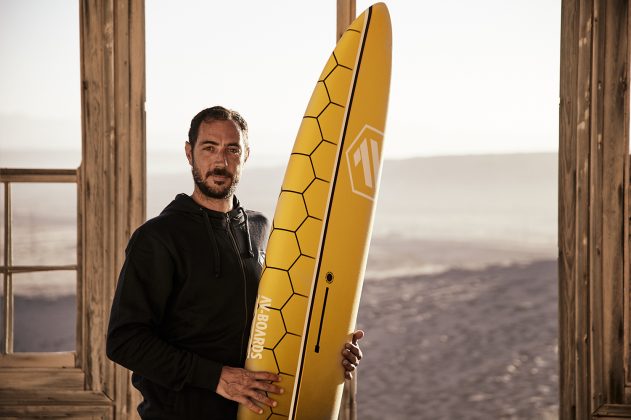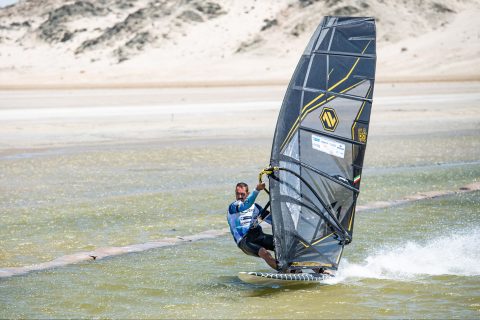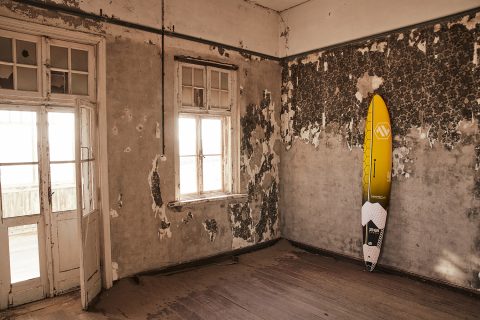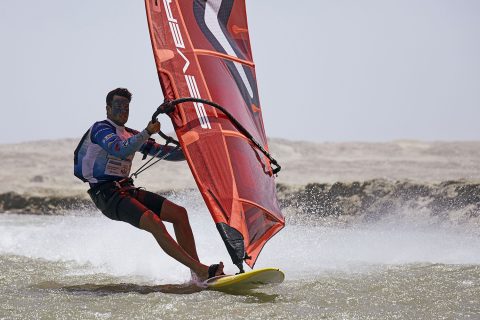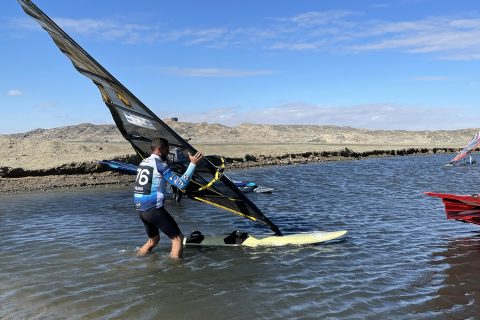AURELIO VERDI: PUSHING THE NEEDLE
Aurelio Verdi of AV-Boards gives us an insight into shaping and sailing some of the fastest windsurfing boards in the world.
WORDS – Aurelio Verdi // PHOTOS – Stefan Csaky/AV-Boards
ORIGINS
During my shaper career at RRD I had the opportunity to shape some speed boards for many team riders, but everything changed in 2015 when I shaped a couple of custom speed boards for RRD team rider at the time, Antoine Albeau. He was looking for something special to bring to Lüderitz. Before then I never realized all the small details that make the real difference in a speed board and all the special features needed to be fast in a dedicated speed canal like Lüderitz!
- Speed run in Luderitz
When Antoine broke the windsurfing world speed record riding my custom boards, it opened up an exciting chapter in my work and a new style of boards to shape and develop.
In 2017 when I started the AV custom factory, I received a lot of requests for speed boards, and one of them was from Bjorn Dunkerbeck. Thanks to Bjorn I met Alberto Possati, my business partner, and with him we started AV-Boards and the first event that we sponsored was the 2019 Lüderitz speed challenge. We decided to produce a special custom speed board, 37 to 42 cm wide, depending on the weight of the rider. So after a lot of work shaping speed boards, I arrived in Lüderitz with 19 custom boards and I was super excited to try its famous canal for the very first time!
Before this speed event, I had never used so small a board or even sailed on speed gear before! And even if I can say that I’m a pretty skilled sailor, I have to say that to ride a speed board in a speed canal is a completely different story!
In fact, when I started to rig my sails and put the asymmetrical fin under my new 38 cm wide board (I’m 78 kg), I started feeling pretty weird. From the very first run I began to understand that my normal stance was wrong, everything I already knew was not enough to race there, and I spent the first few days just learning how to trim and tune everything. And it was thanks to Alberto and the tips of all the other riders that I eventually learned how to go fast down the channel.
- AV speed needle
SHAPE
Well, as everybody today should know, the rocker is the real ‘engine’ of a board, and the real secret for a fast board is in the position and the length of the ‘flat zone’. Our ‘Modena Speed 40’ is the production version of the fastest custom board we used at the 2019 Lüderitz Speed Challenge, and still in its 2021 edition this production board has been the fastest. It is the one that Bjorn used to achieve 103.68 km/h (55.98 knots), his personal best top speed in his windsurfing career!
This board is 227 cm long and 40 cm wide with a volume of 50 litres! The flat rocker runs from the tail to 93 cm from tail, followed by a straight constant bottom curve to the nose. The bottom shape is just flat from the tail to 60 cm from the tail, sliding into a very light 0.5 mm concave to the nose, with a light 1 mm double concave from the front foot to the mast track. The slight concave helps to keep control of the board without losing speed. The outline has the max width moved toward the nose, in order to have a straight outline from mid board to the tail, with a measurement of 24.5 cm wide at 1 foot from the tail. The rail shape is super low to absorb the chop when you ride full speed over 40/50 knots. These are the peculiar features for a speed board to be used only in the Lüderitz speed channel, a special place that has super small chop, even in nuclear wind conditions, as long as it is from the right angle!
On the open sea, rails must be fuller and thicker in the middle section (the mast track zone) to manage the bigger chop, and we put a concave on the deck to lower the pressure centre and gain control. Our Modena Speed 45 and 52 are developed for open seas and have this kind of rail. When you talk about windsurfing at super high speed, of course what you need is to be in control. Control increases confidence and confidence increases the speed! With regards to stance, of course on a speed board it is wider than usual, because with the front foot you need to keep the nose down when you are full speed on a downwind reach.
TECHNIQUE
When you have a look at a speed board you immediately see you are in front of a concept completely different from your usual way to windsurf. These boards are not just 40-45 cm wide at their widest point, with basically no volume, but they also have a super narrow tail, and a super short fin! Normally we use 19 or 19.5 cm fins with 5.2 sails and no more than 20 and 20.5 cm fins with 5.5-5.7 sails, so you need a super light rear foot to avoid a dangerous spin-out!
So you need a completely different stance to ride with a completely different board. You have to ride on a full downwind course, and you have to stretch your front leg to push the board downwind, you also need to put pressure on the front foot to keep the nose down and to keep the back foot light and in control. Meanwhile you need to keep your shoulders parallel to the rail of the board in order to push the sail forward while keeping it open to avoid losing wind and speed on your downwind course. To reach the right speed stance you have to trim your boom, lowering it down and shortening the harness lines, in order to stay more close and more centred on the board. That’s what worked for me, and others may have a different view, but it’s a matter of experience to find what works, and luckily for me, Lüderitz Speed Challenge is the kind of a place where riders love to share their knowledge in order to allow everybody to raise the bar faster. You learn so much after every session there.
- AV in action
EXTREME
Speed sailing is an extreme side of our sport as much as big wave riding. Danger is always around the corner and to enjoy it to the full you need high skills, practice and dedication. Then if you are looking to set a new record you also need the right equipment. The pros make everything look very easy and simple. They jump on the board and start like it as easy as drinking a glass of water. For me I need to waterstart with both feet already in the footstraps in order to avoid a dangerous rodeo!
Just to give you an idea of the difference between an average rider like me and a real pro, I can tell you this story. In the 2019 Lüderitz Speed Challenge, conditions were almost perfect. It was my first experience, I had no fear and no regrets, and it was almost easy for me to break the 40-knot barrier and to reach 45 knots of average speed on a 500-metre course. But this time in the 2021 Lüderitz Speed Challenge, for the very first time, the wind came for all the duration of the event from a wider angle, so the wind generated a higher chop on the second half of the course, just while you were on a broad downwind reach, so you had to push more on the sail to keep it in front of you. The result was that in these conditions it was very easy to lose control. Many riders had big crashes and I did too! I had a big catapult! It was completely unexpected, super painful and I hurt my face. I completely lost my confidence and in the last few days of competition I was not able to sail fast, because being so scared to catapult again I lost all my confidence.
- Heading out at Luderitz
In contrast to this story, let me rewind to the 2015 Lüderitz Speed Challenge, when Antoine Albeau touched a stone with his fin and had a disaster catapult where he was launched into the air at over 50 knots. When he landed he bounced like a stone on the water and hurt his back badly. He had physio all night long, but the day after he recorded the new world record and almost all the attempts that he registered that day were over 52 knots! That’s the sign of a true pro coming back so strong after a big crash like that!

